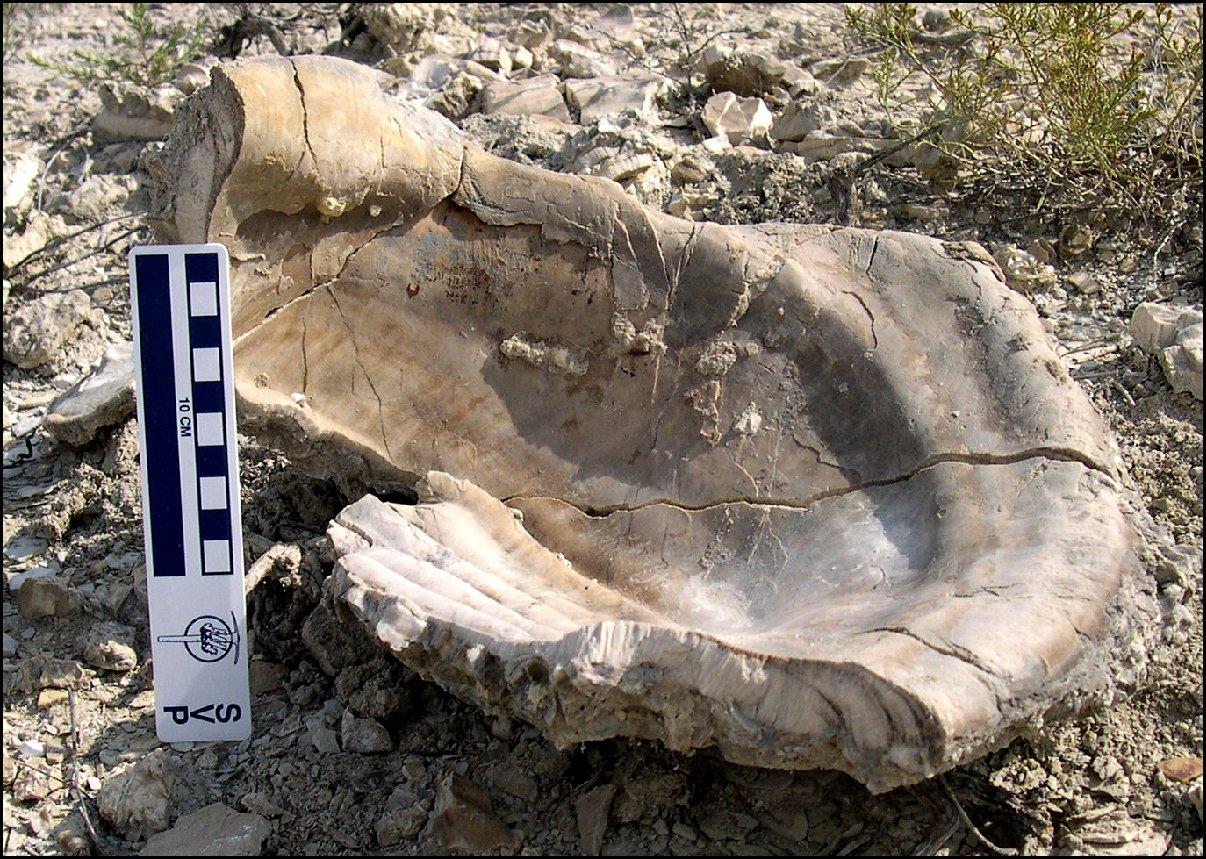 |
Inoceramids
Giant clams of the Cretaceous
Copyright © 2011 by Mike Everhart
Page Created 11/28/2011
Last revised 11/28/2011
LEFT: A large and relatively uncrushed lower
valve of Volviceramus grandis from the Late Coniacian Smoky Hill
Chalk of Trego County, Kansas.
|
Inoceramids: Some species of clams (bivalves) grew to
giant size in the late Cretaceous, attaining diameters of four feet or more. In cross
section, these shells are composed of prismatic (calcitic)
crystals. The inner, nacreous (Mother of Pearl) layer of the shell (composed
of aragonite) was usually
dissolved during fossilization and the outer portion is usually covered with colonies of
oysters and other invertebrates. Pearls are occasionally found
pressed into the Inoceramid shell. According to Sowerby 1823, Inoceramus
means "fibrous shell," describing the prisms that are visible on the
edge of shell
fragments. Inoceramus cuvieri was the first species of Inoceramus
that was formally described by Sowerby (1814). Several species are found in the
Late Cretaceous rocks of Kansas. At times in the Western Interior Sea, they
provided shelter for various small fishes and at least one species of eel. They
also produced pearls.
 |
Inoceramid shells were discovered in Great Britain and
France in the late 1700s and early 1800s, but they were seldom found
complete. Europe in the James Parkinson (1811b) wrote one
of the first descriptions of inoceramid shell fragments, in this case Inoceramus
cuvieri
from the English chalk:
"Fragments of thick shell of a fibrous structure: The doubts expressed respecting the nature of this
shell, and the observations made with regard
to it, offer another strong point of agreement between the shells of the
two strata. The shell here alluded to is most probably
that represented Org. Rem. vol.
III. pl. V.-fig. 3; the structure of which agrees exactly with that
mentioned as found in the French stratum of- chalk. That shell is however
described as being of a tubular form; it is therefore right to observe,
that fossil
that represented Org. Rem. vol.
III. pl. V.-fig. 3; the structure of which agrees exactly with that
mentioned as found in the French stratum of- chalk. That shell is however
described as being of a tubular form; it is therefore right to observe,
that fossil pinnae do
sometimes
possess
this peculiar structure."
LEFT:
Figure 3 from Plate V in Parkinson's Organic Remains of a Former World
(1811a).
|
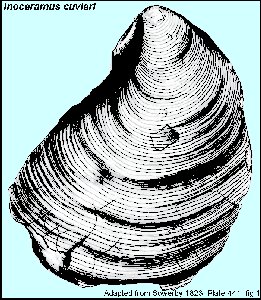 |
LEFT: A drawing of Inoceramus cuvieri Sowerby
(1814) from Great Britain as figured in Sowerby and Sowerby (1823). I.
cuvieri is fairly common in the Greenhorn and Carlile (Turonian)
formations in Kansas, but I had never paid much attention to it. In late
2011, I needed the citation for the name given by Sowerby and discovered
that it wasn't really that easy to find. In fact the first citation that I
worked with was incredibly wrong. The citation pointed back to seven
volumes of a book written by Sowerby between 1812 and 1843 called "The Mineral Conchology of
Great Britain
, or Colored Figures and Descriptions of those Remains of Testaceous
Animals or Shells, Which have been Preserved at Various Times and Depths
in the Earth." ... After some searching, I found Inoceramus
cuvieri described and figured (left) in Volume 5, but the volume had
been published in 1823, not 1814. So I kept looking. The solution to the
mystery was found on page 457 of a paper published by James Sowerby in
1822.
A note at the beginning of the paper states that it had been read orally on
November 1, 1814 by James Sowerby (1757-1822) before a meeting of the Linnean Society. There was no explanation of the delay in publication:
Sowerby, J. 1822. On a fossil shell of a fibrous
structure, the fragments of which occur abundantly in the chalk strata and
in the flints accompanying it. Transactions of the Linnean Society of
London
XIII: 453-458. Plate XXV.
RIGHT:
James Sowerby (1757-1822) portrait in Volume 7. His son, James De Carle Sowerby (1787-1871)
continued the publication of Sowerby's conchology books starting with Volume 5.
Volume 7 was never finished. |
 |
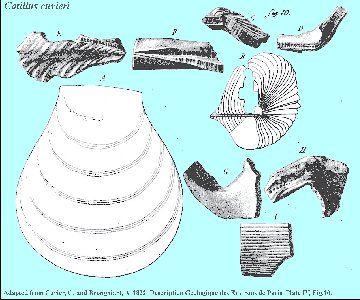 |
LEFT: It is worth noting that about the same time, Cuvier
(1822) described a similar species from France, and indicating that it differed
from Inoceramus in some ways, but also credited the work of Sowerby
and James Parkinson:
"Fig. 10,
A, E, F, G, H,
I.
Catillus cuvieri, A. BR. (p.15) Inoceramus cuvieri, SOW., PARK.
The
name Inoceramus has been given
to shells which seem to me show so numerous and striking differences that
I could not decide to keep them together, breaking the law I imposed
myself to bring no change in the shells division (family), such as it had
been established by the specialists. One has just to compare the fossil
shells that I unite here under the name of Catillus
with Inoceramus, fig.11 and 12,
pl.
VI, to be stricken by this difference. The species of both these genera
are found in the chalk, but they are located in very distant strata.
It
has seemed logical for me to keep the name Inoceramus
for the gender composed of the
shells that M. Parkinson made known and drew under this name in the first
volume of the Transactions of Geol. Soc. of London., that M. Sowerby
established and presented under this same name at the Linnaean Soc. of
London in 1814, of which figures he just published in plates 305 and
306 in
Conchology, and I have preferred give a new name to the species for
which I see no description nor precise figure anywhere.
I
haven't yet seen an entire individual of this species, so that the genus
itself is difficult to characterize; but with the help of hinge fragments
from various collections, with the figures published by MM. Parkinson and
Mantell, one can succeed in characterizing satisfactorily this genus
so
as it can be recognized by geologists, and give them a way to designate in
a uniform manner so remarkable a shell commonly found in the white chalk."
(Translation by Jean-Michel Benoit) |
| Note here that there is some question as to the meaning
of the genus name, Inoceramus, given on some Internet web sites as
"strong pot" or "a muscle + an earthen vessel").
The issue has been around almost as long as the name and was addressed by
James D.C. Sowerby (1823, p. 56):
"The name Inoceramus,
from [unreadable] (fibra) and
ϰέραμος (testa) is justly objected to
by scholars, as an improperly formed word, and not expressive of
"fibrous shell" which it was intended to signify; it therefore
ought to be changed, but it bas been in use so long, that it has become
general; and, if I were even inclined to act the part of an innovator, to
do so would, I think, only be adding to the confusion already existing in
consequence of Brongniart's naming the type of the Genus, Catillus,
a name not applicable to the whole of the species." |
Volviceramus grandis (Conrad 1875) - Late
Coniacian
| Volviceramus grandis: A common clam found in the lower
third (late Coniacian) of the chalk. The lower shells are thick and generally bowl shaped.
In many areas, the surface of the chalk is littered with thousands of fragments of this
shell, some of which may resemble bone in outward appearance. Examination
of the edge of the fragment will determine if it is bone (porous) or shell
(crystalline structure). |
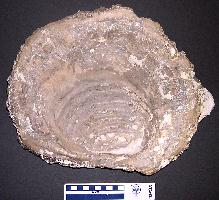 |
LEFT: Volviceramus grandis - A common, large bivalve in
the lower Smoky Hill chalk. This lower valve measures 12 inches by 10 inches. Click here for a view of the other side of this
shell which is encrusted with Pseudoperna congesta oysters. RIGHT:
A juvenile V. grandis lower valve with attached P. congesta oysters.
This shell measures about 2.5 by 2.0 inches. The shell crushing shark, Ptychodus, most likely fed on shells that were about
this size. |
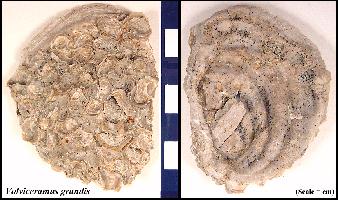 |
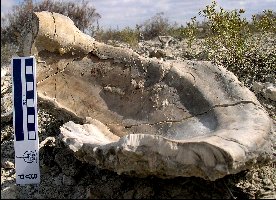 |
LEFT: A field photograph of a medium sized Volviceramus grandis
shell that was relatively uncrushed and shows the depth and the bowl shape. Specimen was
discovered in the
lower chalk of Trego County RIGHT: A field photograph of a
fairly complete V.
grandis shell from the lower chalk of Trego County with the upper (right) valve still
in place, and completely covered with Pseudoperna congesta oysters. The
bottom of this specimen was also completely covered with oysters. |
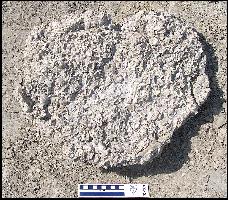 |
Cladoceramus undulatoplicatus Early Santonian
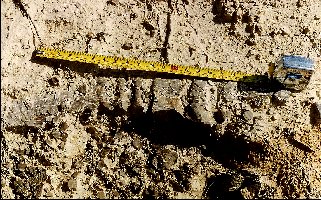 |
Cladoceramus undulatoplicatus: A large
inoceramid that
occurs in a limited zone about 1/3 of the way up from the base of the chalk
(above Marker Unit 7). This zone straddles the boundary between the
Coniacian and Santonian ages, making it useful world-wide as a
stratigraphic marker. The shell of Cladoceramus undulatoplicatus
is
characterized by deep ripples and it has been referred to as the "Snowshoe Clam." LEFT:
A field photo from 1996 showing the edge of a large Cladoceramus undulatoplicatus eroding from the edge of
a gully in the lower Smoky Hill Chalk, Gove County, Kansas. This shell was
near a Pteranodon sternbergi specimen
discovered by Pam Everhart and helped to establish the age of those
remains.
|
Platyceramus platinus Logan 1898 - Latest Coniacian
through Early Campanian:
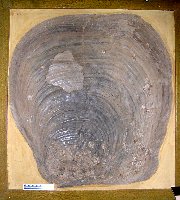 |
Platyceramus platinus is a very large clam shell that occurs throughout the chalk,
sometimes reaching more than four feet in diameter in Kansas. They are thought to be the largest
clams ever, reaching nearly 9 feet in length (3-4' width) in the Niobrara of
Colorado (see Kauffman, et al, 2007). As the name implies, these shells are
relatively flat and often very thin. While alive,
the interior sometimes served as shelter for schools of small fish which are occasionally
preserved inside as fossils pressed into the shell. (See Stewart 1990 and
others) LEFT: The
exhibit specimen of Platyceramus platinus (FHSM IP-532) at the Sternberg Museum.
This shell is about 3 ft. wide and 3.5 feet long (Scale = 10 cm). As
collected by G.F. Sternberg, this would have been the lower side of the
specimen as discovered (Here in a
1960s photo, Dr. L.D. Wooster looks on as George Sternberg points
out a colony of oysters.)
|
 |
LEFT: Part of a large Platyceramus platinus eroding from
the middle of the Smoky Hill Chalk. (Scale = 6 in / 15 cm). There has been some
controversy regarding the orientation of these clams as they sat on the sea bottom because
oysters (Pseudoperna congesta) have been found on both sides. Stewart (1990)
suggested that they sat upright, something like modern giant clams are found in modern
coral reefs. Others (Kauffman, et al., 2007) indicate that they usually occurred in a
recumbent mode, with the left valve on the sea floor. Since the shells are somewhat bowl
shaped, this would allow oysters to colonize the lower portion around the edges.
Otherwise, the shell could have been colonized after it had died and been turned
over (although it is unknown "how" it would have been turned
over).
RIGHT: My concept of a giant (> 1m) Platyceramus
platinus resting on the sea floor with a rather large area of the rim of the lower
shell exposed above the sediment... a great location for oysters looking for a home. |
 |
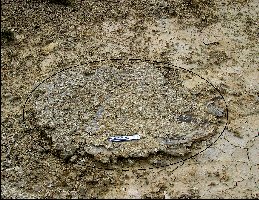 |
LEFT: A very large P. platinus shell eroding from the
lower chalk of Trego County. The shell is almost completely covered with Pseudoperna
congesta oysters. The shell is about 1 m (39 in.) across. RIGHT:
Platyceramus platinus shells were so large that they provided shelter for schools
of small fish. Sometimes the fish were trapped inside the clam's shell when it died.
This picture shows skeletal fragments of small fish that were preserved inside a Platyceramus
platinus shell from the Smoky Hill Chalk. |
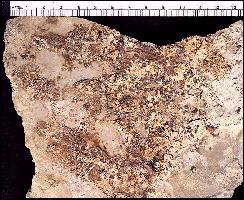 |
 |
LEFT: A rare Cretaceous Urenchelys eel preserved
on a Platyceramus shell from the mid-Santonian Smoky Hill Chalk in
Gove County. (see Wiley and Stewart 1981)
RIGHT: The remains of two small fish preserved in the same shell as
the eel (left). |
 |
Inoceramid pearls
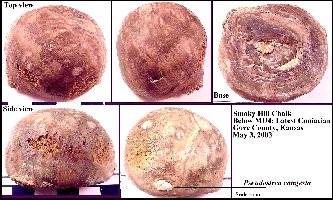 |
As noted by Brown (1940) and Kauffman (1990),
sometimes small round nodules are found attached to inoceramid
shells. They are the remains of pearls that were fossilized along with the clam shell. The
nacre or "mother of pearl" luster is not preserved in inoceramid
pearls. This is because the pearly, nacreous color associated with true
pearls is made up of a mineral called aragonite. In the Smoky Hill chalk, the aragonite is
not preserved. Inoceramid shells and pearls have lost the thin inner pearly aragonite
layer, and are solely composed of calcite. This also means that some kinds of shells, like
those of ammonites, were not preserved because they are composed entirely of aragonite. An
1940 article in the Hays Daily News noted that George Sternberg had donated 50 pearls from
the Smoky Hill Chalk to the Smithsonian Institution, and a scientific paper was published
on their occurrence (Brown, 1940).
LEFT: Several views of a giant fossil
pearl I discovered in the lower Smoky Hill Chalk, Gove County, Kansas. The specimen is the size of half a golf ball.
(Scale = cm) |
 |
LEFT: Three 'pearls' attached to fragments of Inoceramid shells.
The fourth pearl in the lower right was unattached and is a badly formed hemispherical
pearl. RIGHT: A side view of an inoceramid
"blister" pearl showing the
underlying inoceramid shell.
Another group of
pearls and a close-up of
a large pearl from the Smoky Hill Chalk. (Scale =mm) |
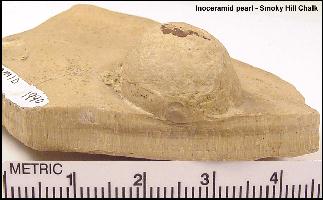 |
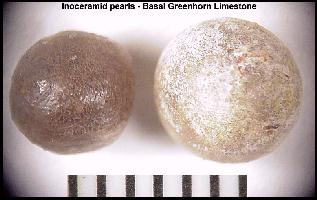 |
PEARLS FROM OTHER FORMATIONS IN
KANSAS
LEFT: Two small pearls (4-5 mm) from the base of the Lincoln Limestone Member
of the Greenhorn Limestone Formation (Upper Cenomanian) in Russell County, Kansas.
(Scale = mm)
RIGHT: A cross section of the larger pearl shown at left showing. the
concentric layers. |
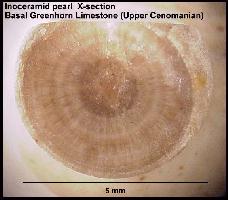 |
| Williston (1897, p. 241) in his paper on the Kansas
Niobrara Cretaceous made the following comments:
"INVERTEBRATES.
Of
the Mollusca, Ostrea congesta is
of very great abundance in the Rudistes beds, but much less common in the Hesperornis
beds. They are found attached to other shells, and it may perhaps be in
consequence of the fewness of large shells in the upper strata that their
comparative rarity- may be ascribed. Several species of Inoceramus
are apparently found in all horizons, but the Haploscaphas are abundant
only in the lower horizons, and I never have found H.
grandis or those allied to that species in the upper horizons. On the
Smoky Hill River
near the mouth of the Hackberry [Creek] there are places where these
shells can be gathered by the wagon load, often distorted, but not rarely
in extraordinary perfection. A very thin shelled Inoceramid [Platyceramus
platinus] measuring in the largest specimens forty-four by forty-six
or eight inches is not rare over a large part of the exposures. Invariably
where exposed, as they sometimes are in their entirety on low fiat mounds
of shale, they are broken into innumerable pieces. For that reason, I have
never known of one being collected complete, or even partially complete.
Notwithstanding their great size the shell substance is not more than an
eighth of an inch in thickness."
|
Suggested references:
Brown, R.W. 1940. Fossil pearls from the Colorado group of western
Kansas. Washington Academy Science 30(9):365-374. (article
in TIME magazine, 1940)
Cuvier, G. and Brongniart, A. 1822. Description
Géologique des Environs de Paris. Paris, 428 pp. Pl.
I-XI.
Conrad, T.A. 1875. Descriptions of Haploscaphae from
the
Niobrara
. pp. 23-24 in Cope, E.D., The Vertebrata of the Cretaceous formations of the
west,
U.S.
Geol.
Survey
Territories
Dhondt,
A V. and Dieni, I. 1990. Unusual Inoceramid-spondylid
association from the Cretaceous Scaglia Rossa of Passo del Brocon (Trento, N.
Italy) and its palaeontological significance. Memorie di Scienze
Geologiche, 42:155-187, 10 fig. 3 pl.
Hattin, D.E. 1962. Stratigraphy of the Carlile Shale
(Upper Cretaceous) in Kansas. State Geological Survey of Kansas, Bulletin 156,
(University of Kansas pub.) 155 p. 2 pl.
Hattin, D.E. 1965. Stratigraphy of the
Graneros Shale (Upper Cretaceous in central Kansas. Bulletin 178, Kansas
Geological Survey, 83 pp.
Hattin, D.E. 1975. Stratigraphy and
depositional environment of the Greenhorn Limestone (Upper Cretaceous) of
Kansas. Bulletin 209, Kansas Geological Survey, 128 pp.
Hattin, D.E., 1982. Stratigraphy and depositional
environment of the Smoky Hill Chalk Member, Niobrara Chalk (Upper Cretaceous) of
the type area, western Kansas. Kansas Geological Survey Bulletin 225, 108 pp.
Hattin, D.E. and Siemers, C.T. 1978. Upper
Cretaceous stratigraphy and depositional environments of western Kansas.
Guidebook Series 3, AAPG/SEPM annual meeting, Kansas Geological Survey, 55 pp.
(Reprinted 1987)
Kauffman, E.G. 1972. Ptychodus predation upon a
Cretaceous Inoceramus. Palaeontology, 15(3):439-444.
Kauffman, E.G. 1990. Giant fossil inoceramid bivalve pearls. pp. 66-68 In
Boucot, A. J., Evolutionary Paleobiology and Coevolution. Elsevier, Amsterdam.
Kauffman, E.G., Harries, P.J., Meyer, C.,
Villamil, T., Arango, C. and Jaecks, G. 2007. Paleoecology of giant Inoceramidae (Platyceramus)
on a Santonian seafloor in Colorado. Journal of Paleontology
81(1):64-81.
Logan, W.N. 1897. The upper Cretaceous of Kansas; with an
introduction by Erasmus Haworth: Kansas Geological Survey, Vol.2, p. 195-234
Logan, W.N. 1898. The invertebrates of the Benton,
Niobrara and Fort Pierre groups. The University Geological Survey of Kansas, Part
VIII, 4:432-518, pl. LXXXVI-CXX.
Logan, W.N. 1899. Some additions to the Cretaceous
invertebrates of Kansas. Kansas University Quarterly 8(2):87-98, pl.
XX, XXI, XXII, XXIII. (mostly oysters)
Miller, H.W. Jr., 1968. Invertebrate fauna and environment of deposition
of the Niobrara (Cretaceous) of Kansas. Fort Hays Studies, n. s., science series
no.8, i-vi, 90 pp. (Tusoteuthis longa and Niobrarateuthis bonneri
are described, pp 53-56)
Miller, H.W. 1969. Additions to the fauna of the Niobrara Formation of
Kansas. Kansas Academy of Science, Transactions 72(4):533-546. (published July
15, 1970)
Parkinson, J. 1811a.
Organic Remains of a Former World – An Examination of the Mineralized
Remains of the Vegetables and Animals of the Antediluvian World. Vol III,
Whittingham and Roland, London, i-xv, 479 pp., plates I-XII, index.
Parkinson,
J. 1811b.
Observations on some of the strata in the neighborhood of
London
, and on the fossil remains contained in them. Transactions of the
Geological Society of
London
1(XIV):324-354.
Roemer,
F. 1852. Kreidebildungen von Texas und ihre organischen
Einschlusse. vi +100 pp. Adolph Marcus,
Bonn
.
Sowerby, J. 1822. On a fossil shell of a fibrous
structure, the fragments of which occur abundantly in the chalk strata and
in the flints accompanying it. Transactions of the Linnean Society of
London
XIII: 453-458. Plate XXV.
Stewart, J.D. 1990. Preliminary account of
holecostome-inoceramid commensalism in the Upper Cretaceous of Kansas. pp.
51-57, In Boucot, A. J., Evolutionary Paleobiology and Coevolution.
Elsevier, Amsterdam.
Stewart, J.D. 1990. Niobrara Formation
vertebrate stratigraphy, pages 19-30, In Bennett, S. C. (ed.),
Niobrara Chalk Excursion Guidebook, The University of Kansas Museum of Natural
History and the Kansas Geological Survey.
Stewart, J.D. 1990. Niobrara Formation
symbiotic fish in inoceramid bivalves. p. 31-41 In S. Christopher
Bennett (ed.), 1990 Society of Vertebrate Paleontology Niobrara Chalk excursion
guidebook. Museum of Natural History and the Kansas Geological Survey, Lawrence,
KS.
Wiley, E.O. and Stewart, J.D. 1981. Urenchelys
abditus, new species, the first undoubted eel (Teleostei:
Anguilliformes) from the Cretaceous of North America. Journal of Vertebrate
Paleontology 1(1):43-47.
Williston, S.W. 1897. The
Kansas Niobrara Cretaceous, The University Geological Survey of Kansas,
2:237-246.





















